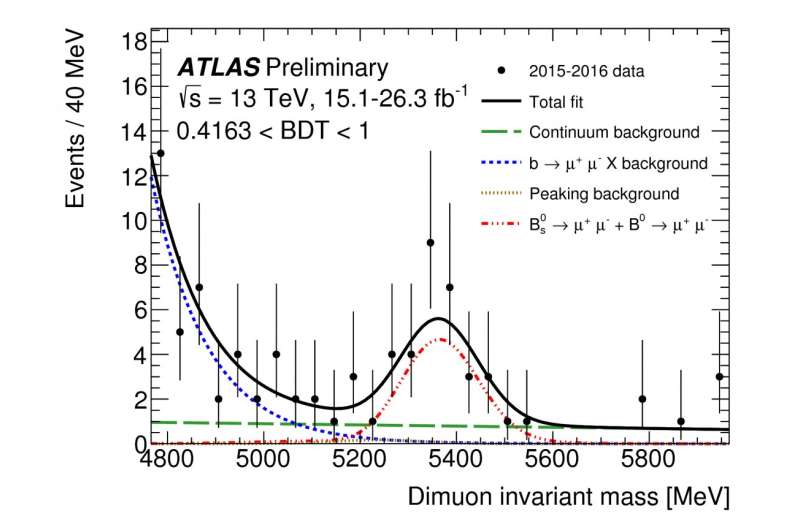ATLAS Experiment releases new study of ultra-rare B-meson decay

The study of hadrons—particles that combine quarks to form mesons or baryons—is a vital part of the physics programme by researchers of the ATLAS Experiment at CERN. Their analysis has not only perfected the understanding of the Standard Model, it has also provided excellent opportunities for discovery.
Among the variety of hadrons available in nature and produced in proton-proton collisions at the Large Hadron Collider, B-mesons play a fundamental role. They are bound states of two quarks—one a bottom quark, the other from among the lighter quarks (up, down, strange or charm)—that decay through the weak interaction to lighter hadrons and/or leptons. In recent decades, physicists have examined rare and precisely predicted phenomena involving neutral B-mesons (i.e. B0or Bs mesons), searching for slight discrepancies from predictions that could be a signal of new physics.
On 20 September 2018, at the International Workshop on the CKM Unitarity Triangle (CKM 2018), ATLAS revealed the most stringent experimental constraint of the very rare decay of the B0meson into two muons (μ). The result is a new milestone that complements analyses previously published by LHC experiments dedicated to the study of B-mesons in a quest spanning almost three decades.
The rareness of this decay is due to the coincidence of two factors: First, the decay requires quantum loops with several weak interaction vertices, some of which have a low probability to occur; second, angular momentum conservation constrains the decay products of the scalar B0 or Bs meson into a highly unlikely configuration.
According to the Standard Model, the probability of generating this decay is about 1.1 in 10 billion. The new ATLAS result gets very close, with the tightest available upper limit of 2.1 occurrences in 10 billion at the 95 percent confidence level. The result was obtained using data collected in 2015 and 2016 combined with an analogous analysis of Run 1 data. The result also provided a 4.6 standard deviations evidence for the Bs→ μμ decay, whose branching fraction is measured to be 2.8 +0.8–0.7 x10–9. It confirms previous measurements from the LHCb and CMS collaborations.
This new ATLAS result is the first milestone toward a more precise measurement that will be obtained with the full Run 2 dataset, which is expected to improve the current precision by about 30 percent. further projections toward the high-luminosity LHC (HL-LHC) era predict that ATLAS will be able to further improve the precision of this result by about a factor of three.
More information: Study of the rare decays of B0s and B0 into muon pairs from data collected during 2015 and 2016 with the ATLAS detector (ATLAS-CONF-2018-046): atlas.web.cern.ch/Atlas/GROUPS … ATLAS-CONF-2018-046/
Provided by ATLAS Experiment





















